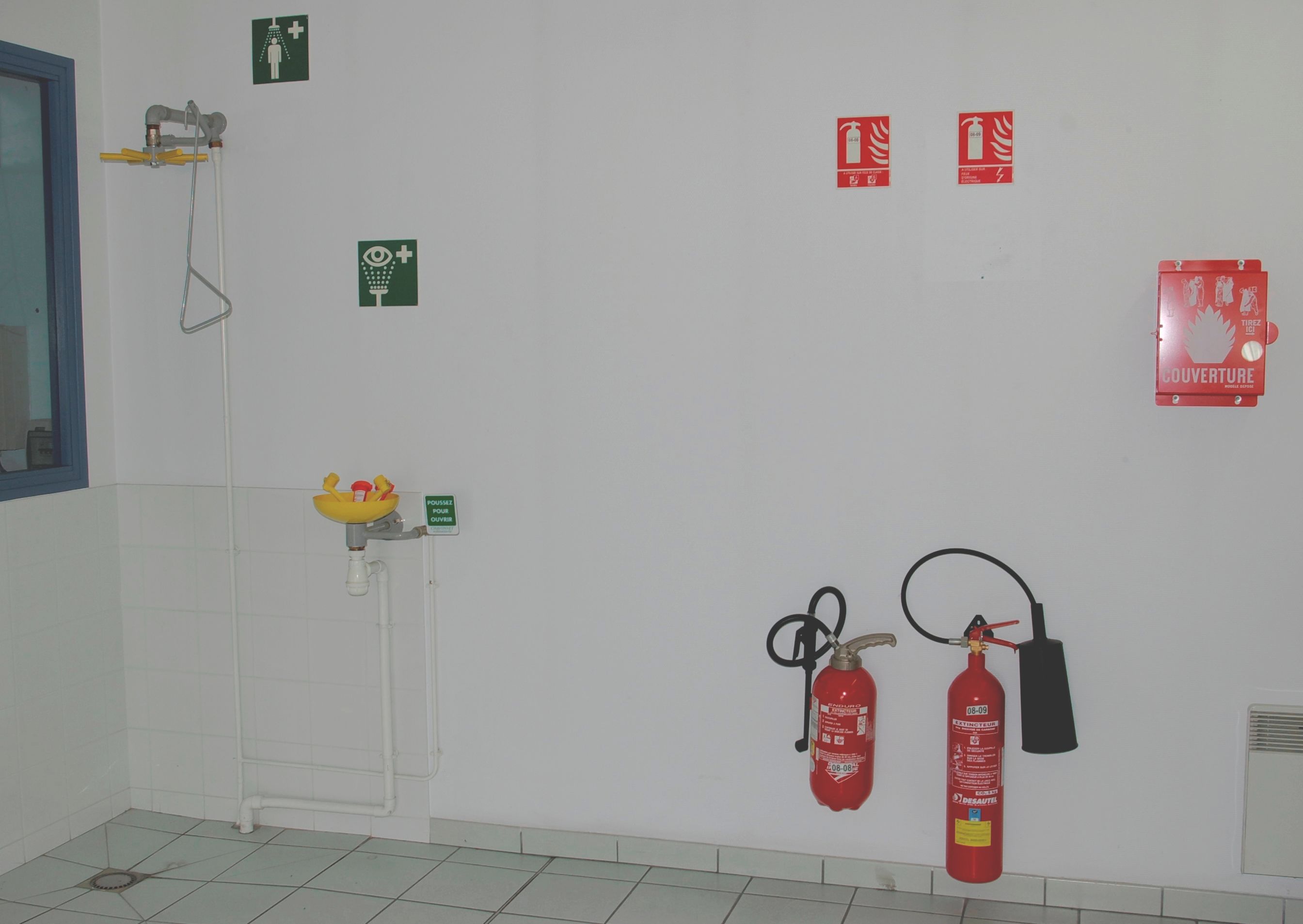Laboratory
A laboratory is a building, part of a building, or other place equipped to conduct scientific experiments, tests, investigations, and practice within one or multiple fields of study.[1] This may also be referred to as a science laboratory or research laboratory.[2][3] Such labs take many forms because of the differing requirements of specialists in the various fields of science and research. For example, a physics lab might contain a particle accelerator or vacuum chamber, while a metallurgy lab could have an apparatus for casting or refining metals or for testing their strength. A chemist or biologist might use a wet laboratory, while a psychologist's lab might be a room with one-way mirrors and hidden cameras in which to observe behavior.
Despite the great differences among laboratories, some features are common. The use of workbenches or countertops at which the scientist may choose to either sit or stand is a common way to ensure comfortable working conditions. Cabinets for the storage of laboratory equipment are also quite common. Scientists have traditionally recorded an experiment's progress in a laboratory notebook, but modern labs almost always contain at least one computer workstation for data collection and analysis, utilizing tools like laboratory information management systems (LIMS) or electronic laboratory notebooks (ELN).
Scientific laboratories can be found in schools and universities, in industry, in government or military facilities, and even aboard ships and spacecraft. A laboratory might offer work space for just one to more than 30 researchers depending on its size and purpose. Recently, a new type of laboratory called an "open laboratory" has emerged. Its format allows the sharing of space, equipment, and support staff among different students and research groups, and it also fosters information exchange through communications across fields. Current examples include the Electrical and Computer Engineering Lab at Temple University[4] and all the laboratories at The Mechanobiology Institute of Singapore.[5]
Types of laboratories
Scientific or research laboratories are as diverse as there are specialties. However, the title of laboratory is also used for certain other facilities where the processes or equipment used are similar to those in scientific laboratories. These notably include:
- medical lab
- public health lab
- forensic lab used to process crime scene evidence
- computer lab
- media lab
- film laboratory or darkroom
- clandestine lab for the production of illegal drugs
In recent years government and private centers for innovation in learning, leadership, and organization have also adopted "lab" in their name to emphasize the experimental and research-oriented nature of their work.
Laboratory safety
In some laboratories, the conditions are no more dangerous than in any other room. In many labs, though, hazards are present. Laboratory hazards are as varied as the subjects of study in laboratories, and might include poisons; infectious agents; flammable, explosive, or radioactive materials; moving machinery; extreme temperatures; lasers; strong magnetic fields; or high voltage. In laboratories where dangerous conditions might exist, safety precautions are important. Rules exist to minimize the individual's risk, and safety equipment is used to protect the lab user from injury or to assist in responding to an emergency.[6]
In the laboratory regular inspections and audits help assess hazards due to chemical handling and storage, electrical equipment, biohazards, hazardous waste management, housekeeping and emergency preparedness, radiation safety, ventilation, and air quality. An important element of such audits is the review of regulatory compliance and the training of individuals who have access to and/or work in the laboratory. Training is critical to the ongoing safe operation of the laboratory facility. Educators, staff and management must be engaged in working to reduce the likelihood of accidents, injuries, and potential litigation. Training may include laboratory safety videos that are both relevant and engaging.[7]
Standards and guidance
The following entities create standards and guidance for laboratory safety around the world:
- American National Standards Institute (ANSI)
- Clinical and Laboratory Standards Institute (CLSI)
- International Electrotechnical Commission (IEC)
- International Organization for Standardization (ISO)
- National Institute for Occupational Safety and Health (NIOSH)
- Occupational Safety and Health Administration (OSHA)
Notes
Some elements of this article are reused from the Wikipedia article.
References
- ↑ "laboratory". Merriam-Webster Dictionary. Merriam-Webster, Inc. https://www.merriam-webster.com/dictionary/laboratory. Retrieved 06 January 2022.
- ↑ "laboratory". WordNet Search. Princeton University. http://wordnetweb.princeton.edu/perl/webwn?o2=&o0=1&o8=1&o1=1&o7=&o5=&o9=&o6=&o3=&o4=&s=laboratory. Retrieved 10 September 2013.
- ↑ Russo, Jose (2011). "Chapter 5: What is a Research Laboratory?". The Tools of Science: The Handbook for the Apprentice of Biomedical Research. World Scientific. pp. 133–142. ISBN 9814293164. https://books.google.com/books?id=GSAtu-yc-vkC.
- ↑ "The Electrical & Computer Engineering Department's interchangeable and portable lab equipment makes interactive learning a reality". Temple University. Archived from the original on 28 September 2013. https://web.archive.org/web/20130928054509/http://engineering.temple.edu/electrical-computer-engineering/labs-equipment. Retrieved 06 January 2022.
- ↑ "MBI Laboratories". The Mechanobiology Institute. https://www.mbi.nus.edu.sg/services/core-facilities/laboratories/. Retrieved 06 January 2022.
- ↑ Gile, Terry Jo (2004). "Chapter 1: The Law and Science of Laboratory Safety". Complete Guide to Laboratory Safety. HC Pro, Inc. pp. 1–12. ISBN 1578395313. https://books.google.com/books?id=AnHuuIngEcAC.
- ↑ Matson, Michael L.; Fitzgerald, Jeffrey P.; Lin, Shirley (2007). "Creating Customized, Relevant, and Engaging Laboratory Safety Videos". Journal of Chemical Education 84 (10): 1727. doi:10.1021/ed084p1727.











